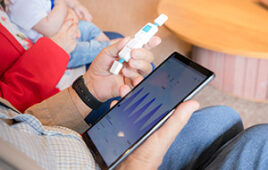For millions of Americans at risk for blood clots, strokes and hypertension, routine lab tests to monitor blood-thinning medications can be frequent, costly, and painful.
But researchers at the University of Cincinnati –– supported by the National Science Foundation –– are developing materials and technology for a simple in-home screening that could be a game changer for patients with several life-threatening conditions.
 Patients with cardiovascular disease, hypertension, atrial fibrillation, congestive heart failure, kidney disease and others who are at risk for blood clotting are especially vulnerable when blood-thinning medication levels get too weak or too strong. This imbalance can quickly lead to ischemic (clotting) or hemorrhagic (bleeding) strokes if not detected in time.
Patients with cardiovascular disease, hypertension, atrial fibrillation, congestive heart failure, kidney disease and others who are at risk for blood clotting are especially vulnerable when blood-thinning medication levels get too weak or too strong. This imbalance can quickly lead to ischemic (clotting) or hemorrhagic (bleeding) strokes if not detected in time.
“We have developed a blood screening device for patients on medications like Coumadin, warfarin or other blood thinners who need to monitor their blood-clotting levels on a regular basis,” says Andrew Steckl, UC professor of electrical engineering in the College of Engineering and Applied Science. “Patients can soon monitor their blood coagulation characteristics from home quickly and painlessly before making needless trips to the lab or hospital.”
Using nanofiber membranes inside paper-based porous materials housed within a plastic cassette, the researchers can quickly reveal the level of the blood’s ability to clot, and all from the convenience of the patient’s living room with a simple finger stick to draw a drop of blood.
While slight changes in the level of coagulation properties will occur normally depending on certain food intake and overall health conditions, Steckl says a major change in levels immediately shows up on the paper-based test stick resulting in clotting patterns registering on one end of the spectrum or the other and will put up a red flag before any physiological trouble starts.
This interdisciplinary research includes faculty and doctoral-student colleagues from the University of Cincinnati’s James L. Winkle College of Pharmacy, the UC Nanoelectronics Laboratory and the UC Department of Electrical Engineering & Computing Systems in the UC College of Engineering and Applied Science.
 “This simple test is not intended to replace the very careful and accurate measurements that get accomplished in a laboratory facility, but at a relatively minimal cost a patient can do this on their own between scheduled visits or when in doubt,” says Steckl. “And it shouldn’t require a caregiver, as most patients can perform this test quickly on their own.”
“This simple test is not intended to replace the very careful and accurate measurements that get accomplished in a laboratory facility, but at a relatively minimal cost a patient can do this on their own between scheduled visits or when in doubt,” says Steckl. “And it shouldn’t require a caregiver, as most patients can perform this test quickly on their own.”
The test is designed to give each patient the ability to keep a careful check on their levels by monitoring the changes that occur relative to previous tests. The technology can also be calibrated to a specific patient’s condition. For example, a patient whose normal blood coagulation rate is significantly different from the general population because of a genetic disorder can use a tailor-made test kit that includes a different porous membrane.
Using the simple technology may also help patients who have a known inherited blood clotting disorder detect concerning levels early.
“By identifying potential blood-clotting problems early enough, we hope to prevent potential injury or death and the exorbitant associated costs,” says Steckl. “By shifting from what were once mandatory expensive laboratory tests to using more in-home screening tests, patients can take more control of their lives, reduce health-care costs and ultimately save more lives.”
Additional UC colleagues associated with Steckl’s research and conference presentations at the 2016 Meeting of the International Society for Porous Media include: Hua Li, Daewoo Han, Michael Hegener, Giovanni Pauletti, Prajokta Ray, Daoli Zhao, William Heineman, Shima Dalirirad, Vishak Venkatraman. Gerald Kasting, and Lilit Yeghiazarian, along with UC students, arranged and coordinated the 2016 InterPore Conference.
Source: University of Cincinnati




